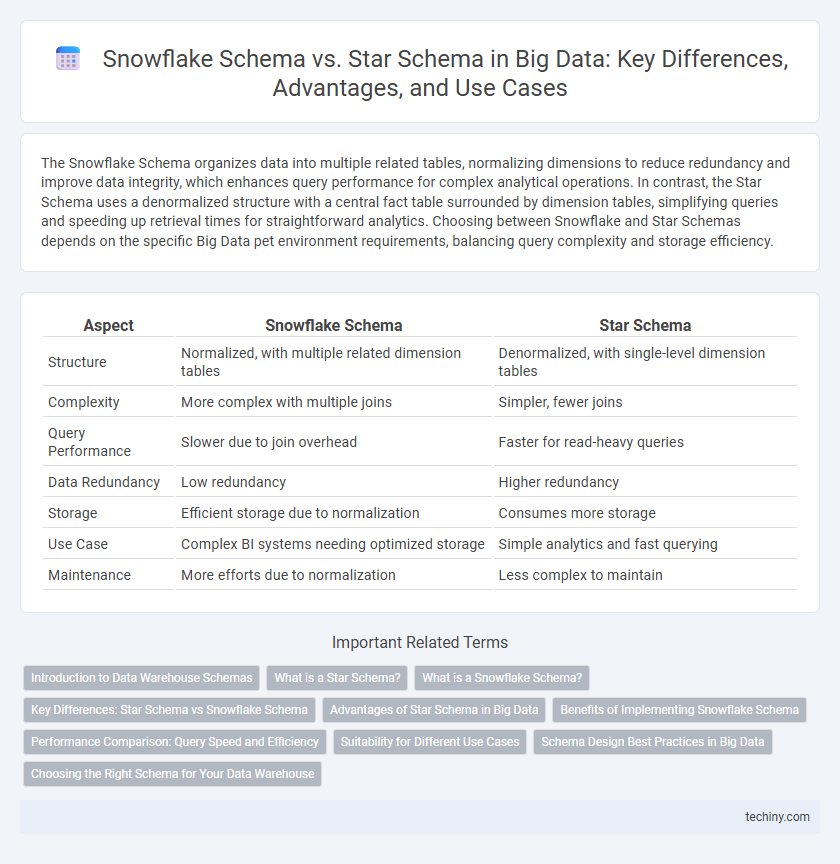The Snowflake Schema organizes data into multiple related tables, normalizing dimensions to reduce redundancy and improve data integrity, which enhances query performance for complex analytical operations. In contrast, the Star Schema uses a denormalized structure with a central fact table surrounded by dimension tables, simplifying queries and speeding up retrieval times for straightforward analytics. Choosing between Snowflake and Star Schemas depends on the specific Big Data pet environment requirements, balancing query complexity and storage efficiency.
Table of Comparison
| Aspect | Snowflake Schema | Star Schema |
|---|---|---|
| Structure | Normalized, with multiple related dimension tables | Denormalized, with single-level dimension tables |
| Complexity | More complex with multiple joins | Simpler, fewer joins |
| Query Performance | Slower due to join overhead | Faster for read-heavy queries |
| Data Redundancy | Low redundancy | Higher redundancy |
| Storage | Efficient storage due to normalization | Consumes more storage |
| Use Case | Complex BI systems needing optimized storage | Simple analytics and fast querying |
| Maintenance | More efforts due to normalization | Less complex to maintain |
Introduction to Data Warehouse Schemas
Snowflake schema and star schema are fundamental data warehouse schemas used for organizing and optimizing big data storage. The star schema features a central fact table connected directly to denormalized dimension tables, enhancing query performance and simplicity. In contrast, the snowflake schema normalizes dimension tables into multiple related tables, reducing data redundancy and improving data integrity at the cost of more complex queries.
What is a Star Schema?
A Star Schema is a data modeling technique used in data warehousing where a central fact table is connected to multiple dimension tables, forming a star-like structure. The fact table contains quantitative data for analysis, while the dimension tables store descriptive attributes related to the facts. This schema simplifies queries and improves performance by minimizing joins compared to more complex schemas like the Snowflake Schema.
What is a Snowflake Schema?
A Snowflake Schema is a logical arrangement of tables in a multidimensional database where the central fact table is connected to multiple normalized dimension tables, forming a structure resembling a snowflake. This schema reduces data redundancy and improves data integrity by splitting dimension data into additional related tables. It is commonly used in data warehousing and big data analytics to enhance query performance and scalability.
Key Differences: Star Schema vs Snowflake Schema
The Star Schema features a central fact table connected directly to denormalized dimension tables, optimizing query performance through simplicity and faster joins. In contrast, the Snowflake Schema normalizes dimension tables into multiple related tables, reducing data redundancy and improving data integrity but potentially increasing query complexity. Star Schema suits data warehousing environments requiring speed, while Snowflake Schema is ideal for scenarios demanding normalized data and intricate analytical queries.
Advantages of Star Schema in Big Data
Star Schema offers faster query performance in Big Data environments by simplifying join operations through its denormalized structure. Its design enhances readability and ease of use for data analysts, facilitating efficient data aggregation and reporting. The straightforward schema reduces query complexity, making it ideal for large-scale analytics in Big Data platforms.
Benefits of Implementing Snowflake Schema
Implementing a Snowflake Schema in Big Data environments enhances query performance by normalizing dimension tables, reducing data redundancy, and improving data integrity. This schema facilitates more efficient storage and maintenance through its hierarchical structure, enabling faster updates and scalability for complex analytical queries. Snowflake Schema also optimizes ETL processes by simplifying the orchestration of incremental data loads and supporting multi-dimensional analysis with finer granularity.
Performance Comparison: Query Speed and Efficiency
Snowflake schema optimizes query speed by normalizing data into multiple related tables, reducing redundancy and improving storage efficiency, which can enhance performance for complex queries involving many joins. Star schema, with its denormalized structure and fewer joins, offers faster query response times for simple and straightforward queries, making it ideal for read-heavy analytic workloads. Overall, star schema tends to deliver higher efficiency and quicker query performance in most Big Data scenarios, while snowflake schema excels in maintaining data integrity and supporting complex queries.
Suitability for Different Use Cases
The Snowflake Schema is suitable for complex data environments requiring normalized data structures, which reduce redundancy and optimize storage efficiency, making it ideal for large-scale analytical queries with intricate hierarchical relationships. The Star Schema, featuring denormalized tables with a simple design, excels in performance-driven scenarios demanding faster query response times, commonly used in data warehousing and business intelligence dashboards. Selecting between Snowflake and Star Schema depends on the balance between query complexity, storage optimization, and performance requirements in big data analytics.
Schema Design Best Practices in Big Data
Snowflake schema optimizes storage by normalizing dimension tables into multiple related tables, reducing data redundancy and improving query performance in complex analytical workloads. Star schema simplifies schema design with denormalized dimension tables directly connected to fact tables, enabling faster query execution and easier understanding for users. Best practices in big data recommend selecting schema design based on query complexity and performance requirements, using snowflake schema for efficient storage and star schema for high-speed querying and simpler data models.
Choosing the Right Schema for Your Data Warehouse
Selecting the appropriate schema for your data warehouse depends on query complexity and performance needs; Snowflake Schema offers normalized tables that reduce data redundancy and improve storage efficiency, making it ideal for complex queries with multiple joins. Star Schema features denormalized tables with a simple structure, enhancing query speed and simplifying data retrieval, which suits environments demanding high performance and ease of use. Understanding your data volume, query patterns, and processing power helps determine whether Snowflake's normalization or Star Schema's simplicity will best optimize your big data analytics.
Snowflake Schema vs Star Schema Infographic

 techiny.com
techiny.com